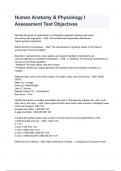Human Anatomy & Physiology I
Assessment Test Objectives
Describe the levels of organization in multicellular organisms starting with atoms
and ending with organisms. - ANS Atoms,Molecules<organelles,cells,tissues,
organs,systems,organisms
Define the term homeostasis. - ANS The maintenance of dynamic steady in the internal
environment "strive for stability"
Describe, in general terms, how negative and positive feedback mechanisms are
used by organisms to maintain homeostasis. - ANS +/- feedback: The general mechanisms of
nervous or hormonal regulation.
- feedback: Provides stable, long term control.
+ feedback: Reinforces original deviation and causes rapid and temporary changes in a
variable.
State the basic units of the metric system for length, mass, time and volume. - ANS BASE
UNITS
Meter (m) - Length
Gram (g) - Mass/Weight
Liter (l) - Volume
Degree Celsius (ºC) - Temperature
Second (s) - Time
Identify the fraction or multiple associated with each of the following prefixes: kilo, deci, centi,
milli, micro, and nano. - ANS Prefix symbol Prefix name Prefix value Fraction or Multiple Power
k kilo one thousand 1000 103
M mega one million 1,000,000 106
G giga one billion 1,000,000,000 109
Combine the prefixes above with a metric unit and know the correct abbreviation of the
combined prefix and unit. - ANS d deci 1/10
0.1 10-1
c centi 1/100 0.01 10-2
m milli 1/1000 0.001 10-3
µ micro 1/1000,000 0.000,001 10-6
n nano 1/1000,000,000 0.000,000,001 10-9
Define the term element - ANS Basic build block of nature --- composed of one type of atom.
,Identify the common chemical symbols for: oxygen, carbon, hydrogen, nitrogen, calcium,
potassium, sodium, chlorine, iron, and phosphorus. - ANS O: Oxygen
C: Carbon
H: Hydrogen
N: Nitrogen
Ca: Calcium
K: Potassium
Na: Sodium
Cl: Chlorine
Fe: Iron
P: Phosphorous
Identify the chemical formulas for carbon dioxide, carbon monoxide, water, hydrochloric acid,
sodium chloride, glucose, and sodium bicarbonate. - ANS CO2: Carbon dioxide
CO: Carbon monoxide
H20: Water
HCI: Hydrochloric acid
NaCI: Sodium chloride
C6H12O6: Glucose
NaHCO3: Sodium bicarbonate
Define the term atom. - ANS Basic unit of matter
Describe the basic structure of an atom. - ANS Atoms consist of three basic particles: *protons,
electrons,* and *neutrons*.
Identify the charge and the location in an atom of protons, neutrons and electrons. - ANS The
nucleus (center) of the atom contains the protons (positively charged) and the neutrons (no
charge). The outermost regions of the atom are called electron shells and contain the electrons
(negatively charged).
Define the term isotope. - ANS Isotopes are atoms which have the same number of protons but
different numbers of neutrons
Recognize that isotopes are used in diagnosis and treatment in medicine. - ANS Radioisotopes
(half-life)
Fluorine-18 is used in nuclear imaging
Erbium-169 is used for relieving arthritis pain in synovial joints.
Iodine-123 is used for diagnosis in thyroid function
Define the terms molecule and ion. Explain the role of electrons in chemical bonding. - ANS
Molecule: The fundamental components of chemical compounds and are the smallest part of a
compound that can participate in a chemical reaction
, Ion: An atom or molecule with a net electric charge due to the loss or gain of one or more.
electrons transferred from one atom to another, electrical attraction
Chemical bonding: Hold the nucleus in place. No electrons, no bonding. Two bare nuclei would
never stick together. Chemical bonding happens because electrons in atoms are looking for
ways to lower their energy. They can do this by transferring to orbitals of lower energy (ionic
bonding) or by spreading out or delocalizing (covalent bonding)
Compare how covalent and ionic bonds hold atoms together and how each type of bond is
shown in a diagram. - ANS Covalent: Also called a molecular bond, is a chemical bond that
involves the sharing of electron pairs between atoms.
Oxygen (6) and Oxygen (6) want to make up their own (8) atoms, they both don't have enough
so they share to pretend they have enough. (4) O (2)(2) O (4)
Ionic: When one atom gives up one or more electrons to another atom.
Sodium- Na (1) >> wants to give up the (1) atom to Cholride- Cl (7) who wants to take it>> Cl is
now (7+1). Na is now Na+ and Cl forms Cl-, together they make NaCl to create table salt
Discuss the relative strengths of covalent and ionic bonds (how easily the bonds can be
broken). - ANS A covalent bond containing Hydrogen has a slight positive charge, the hydrogen
will be attracted to any neighboring negative charges, such as the slight negative charge on the
more electronegative atom of a nearby polar covalent bond breaking up the bond.
Although an individual hydrogen bonds are weak and easily broken, numerous hydrogen bonds
in combination can be very strong.
Ionic Bond such as NaCl you could simply add water. For example, NaCl is table salt. If you add
water, the sodium and chlorine ions will separate thereby breaking the ionic compound into two
pieces.
Compare polar and nonpolar bonds. Compare and contrast the characteristics of polar and
nonpolar molecules. - ANS Polar bond: Electrons are shared but not equally, resulting in a bond
in which one atom has a slightly negative charge and the other a slightly positive charge. Can
be broken by water- salt, sugar (one is positively charged, one negative)
Nonpolar: Electrons are shared equally
Non polar bonds cannot be broken by water- a rock, piece of grass, oils, fats
* The greater the electronegativity difference, the more ionic the bond is. Bonds that are partly
ionic are called polar covalent bonds. Nonpolar covalent bonds, with equal sharing of the bond
electrons, arise when the electronegativities of the two atoms are equal.
Identify the type of bond (polar covalent, nonpolar covalent, or ionic) found in the following
molecules: carbon dioxide, water, hydrochloric acid, sodium chloride, oxygen gas, and sodium
bicarbonate. - ANS Carbon dioxide: Non polar covalent
Water: Polar covalent




